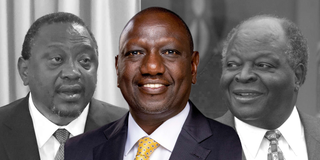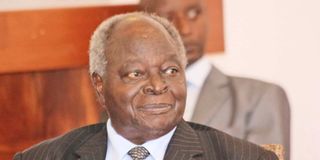
President William Ruto (centre) and former presidents Uhuru Kenyatta (left) and Mwai Kibaki.
In his initial 17-month run, President William Ruto borrowed comparatively more and spent less on development, setting him on a false start compared to his two immediate predecessors in the most critical economic aspects.
This is based on a national analysis of the three Presidents’ priorities when they entered office, which shows that on the revenue side, President Ruto has borrowed 37.8 per cent of the revenues he raised, compared to former President Uhuru Kenyatta who borrowed 31.7 per cent of the revenues in his first 18 months, and Mwai Kibaki’s 26 per cent borrowing as a share of revenues over a similar period from January 2003.
On spending, President Ruto put just 11.7 per cent (Sh551 billion) of the Sh4.7 trillion he spent between October 2022 and February 2024 into development activities, against Uhuru and Kibaki’s 15.6 per cent development spending during their initial 18 months in office.
The analysis of government revenues and spending reveals that while President Ruto finds himself tied in a tight debt-service corner that is taking about half of all the money he is spending, he continues to borrow more and is deviating from his first commitment as President, that “when you find yourself in a hole, you stop digging further.”
Between October 2022 and February 2024, President Ruto’s total government revenues amounted to Sh4.8 trillion, of which taxes accounted for 59.8 per cent while borrowing filled in 37.8 per cent.
While tax contribution to total revenues during similar periods for former Presidents Kibaki and Uhuru was at 59 per cent, the former heads of state borrowed less during their first 18 months in office - Uhuru (31.7 per cent of the Sh2.24 trillion revenues) and Kibaki (26 per cent of the Sh500 billion revenues).

“Now he (President Ruto) has dug that hole, (so that) even coming out of it with elevators will be a nightmare. The country is highly indebted. This means that we are living beyond our means,” says Dr Samuel Nyandemo, Economics lecturer at the University of Nairobi.
Kenya Private Sector Alliance (Kepsa) CEO Caroline Kariuki notes that increased domestic borrowing “has posed a challenge of private sector credit crowding-out effect.”
“Notably half of Kenyan banks were accessing liquidity support from the Central Bank of Kenya (CBK) by the end of September 2023. This challenge in credit access inhibits private sector ability to create job opportunities due to limited funding,” Ms Kariuki says.
Between July 2023 and the end of February, the government borrowed Sh737 billion from domestic and external markets. It had borrowed Sh1 trillion between October 2022 and June 2023.
The high rate of borrowing under the current government has been despite its commitment - in speeches and policy documents - to borrow less and rely on taxes more to implement development priorities, which has seen the government introduce a range of new taxes and levies, which experts and industry leaders now blame for the Kenya Revenue Authority’s (KRA) unyielding taxes.
Among taxes and levies introduced/raised since last year include the 1.5 per cent Housing Levy, increase in Value Added Tax (VAT) on fuel and the export promotion levy.
Kepsa and the Kenya Association of Manufacturers (KAM) have argued that more taxes and levies have affected several sectors' productivity and job creation and have had a counter-productive effect on targeted government revenues.
“When we see KRA missing revenues by Sh36 billion every month, there is an attribution to what is happening in the sectors that have been affected by the Finance Act, 2023,” says KAM CEO Anthony Mwangi, noting that the contribution of many companies to VAT, Import Duty and PAYE has diminished due to increased taxes on businesses and workers.
KAM says the uncertainty of tax policies is a major concern for manufacturers and that newly introduced taxes, especially on industrial inputs, are curtailing manufacturers’ productivity by making them uncompetitive in the region.
“We urge the government to consider not imposing taxes on industrial inputs since no country in the world is self-sufficient in industrial inputs. Imported industrial inputs act as building blocks for exports and imposing taxes on imported industrial inputs denies the country capacity to add value locally and benefit from technologies embedded in imported inputs. Thus, undermining economic growth prospects,” KAM says.
Dr Nyandemo also notes that new tax measures by the government are “disillusioning businesspersons from any serious business engagements because there is no morale and motivation.”
That has been the overall performance on raising revenues.
In putting available money into use, President Ruto - in his initial 17 months - has put Sh11.7 out of every Sh100 he had on development activities, against Sh15.6 that each of his two immediate predecessors put during similar periods (18 months) when they entered office. President Ruto’s spending on development is, thus, about 25 per cent lower.
Government spending on development activities between October 2022 and February 2024 was Sh551 billion out of Sh4.7 trillion. Between April 2013, when former President Uhuru entered power, and September 2014, when his first 18 months in office lapsed, he spent Sh369 billion out of Sh2.36 trillion on development. Kibaki’s development spending was Sh66.4 billion out of Sh425 billion between January 2003 and June 2004.
National Assembly’s Budget Committee Chairman, Ndindi Nyoro, blames low development spending in President Ruto’s government on high allocations to debt service, which he terms as “money that would otherwise go into development” and prioritizing “what must be done first.”
“You ask yourself, between paying a teacher/nurse and building a road, what can wait. It’s a matter of sequencing and it is basically to stabilize. When stability is achieved, now we go back to normalcy of allocating enough resources to development. There has been some tightening in terms of development financing but it’s just a matter of us seeking stability,” Mr Nyoro says.
Between October 2022 and February 2024, the government spent Sh2.3 trillion (49 per cent of total spending) on the Consolidated Fund Services (CFS), which almost entirely constitutes public debt service. Uhuru and Kibaki spent 26 per cent and 11 per cent, respectively, on the item.
“When you hear the President making appeals to global financial institutions to lower rates, it’s basically because all the money we allocate to CFS is going into payment of interest rates. If they just halve the amount they are charging, we would have another leg room of more than Sh400 billion to put into development,” Mr Nyoro says.
However, much of the development spending is diverted to recurrent spending through supplementary budgets within the year, as additional borrowing is factored beyond what had been approved in the original budget.
The Senate's finance committee, in a recent report, notes that the in-year changes now necessitate frequent reporting by the Treasury to Parliament.
“To enhance monitoring and transparency on in-year borrowing operations, at the end of every quarter of the financial year, the National Treasury should submit to the Senate a status report on any deviation from the approved borrowing strategy indicating the reasons for the deviation,” the committee stated in a report on the 2024 Medium term debt management strategy.
While President Ruto’s performance on borrowing and development spending was the lowest among the three Presidents, however, the current Head of State has put a comparatively lower proportion of his spending on recurrent activities - which largely caters for public servants’ salaries, allowances and facilitation of other government operations - compared to Uhuru and Kibaki.
Out of the total spending of Sh4.7 trillion between October 2022 and February 2024, government spending on recurrent activities was Sh1.8 trillion (39.3 per cent ), which was lower than former President Uhuru’s spending of 58.3 per cent and Kibaki’s 73.4 per cent over similar periods, in proportion terms.
Mr Nyoro attributes this to the fact that the government has managed to “cut ‘money for chai’ and reduced MDAs travel budgets and that is bearing fruit.”
However, not everybody believes that the current government’s spending on recurrent activities is sustainable, with Dr Nyandemo noting that the government remains excessively extravagant in travel spending and other luxuries.
“The way out is calling a spade a spade. Revisit our tax policy and the Finance Act, do necessary adjustments. We need to be bold enough and bring certain subsidies in critical areas, particularly essential goods. Failure to this, don’t expect miracles in terms of economic growth,” he says.






